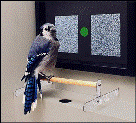Center for Avian Cognition
Date of this Version
1999
Citation
Published in Animal Behaviour, 1999, 57, 1327–1335
Abstract
Clark’s nutcrackers regularly store large numbers of pine seeds and remember the locations of the cached seeds. Although they are very accurate, they do make some errors during recovery. In an attempt to determine whether any behaviours during caching predicted the occurrence of errors during recovery, we videotaped Clark’s nutcrackers while they cached and recovered seeds under laboratory conditions. We used the videotapes to develop complete, quantitative descriptions of caching and recovery behaviour, with an emphasis on body orientation and directions of movement. During caching, the birds showed the greatest change in their orientation and direction following cache creation. During cache recovery, in contrast, body orientation changed most following successful recovery of a seed. When orientation while making a cache was compared with orientation when recovering the same cache, orientations were similar more often than would be expected by chance. However, this consistency of direction was not related to the accuracy of cache recovery, indicating that such consistency is not necessary for accurate cache recovery. The location in which the birds chose to place their caches was the only variable that predicted the location of probes during recovery.
Included in
Animal Studies Commons, Behavior and Ethology Commons, Cognition and Perception Commons, Forest Sciences Commons, Ornithology Commons, Other Psychology Commons


Comments
© 1999 The Association for the Study of Animal Behaviour. Used by Permission.